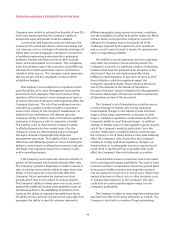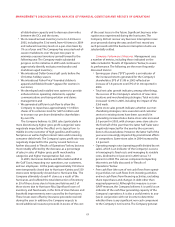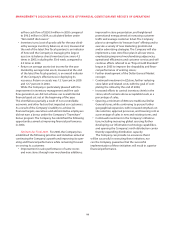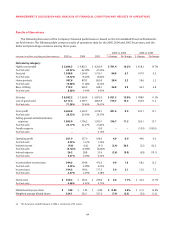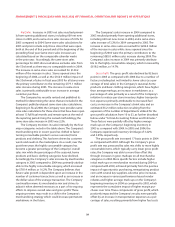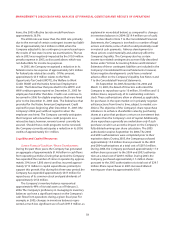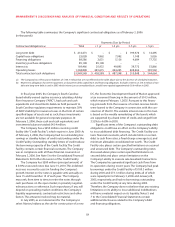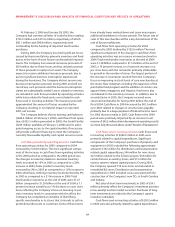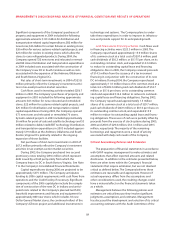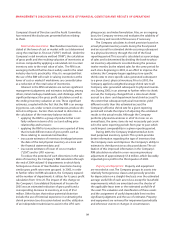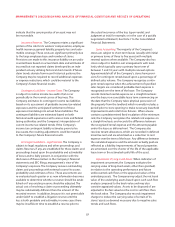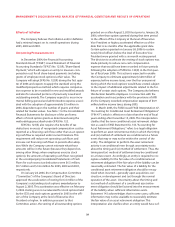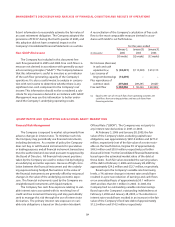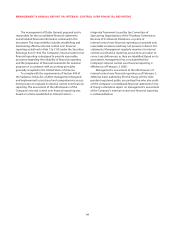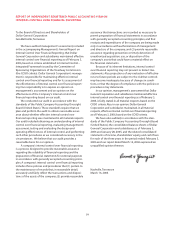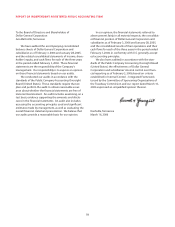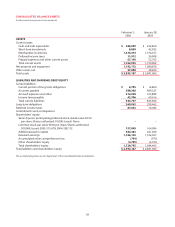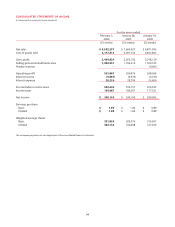Dollar General 2005 Annual Report Download - page 28
Download and view the complete annual report
Please find page 28 of the 2005 Dollar General annual report below. You can navigate through the pages in the report by either clicking on the pages listed below, or by using the keyword search tool below to find specific information within the annual report.
24
MANAGEMENT’S DISCUSSION AND ANALYSIS OF FINANCIAL CONDITION AND RESULTS OF OPERATIONS
At February 3, 2006 and January 28, 2005, the
Company had commercial letter of credit facilities totaling
$195.0 million and $215.0 million, respectively, of which
$85.1 million and $98.8 million, respectively, were
outstanding for the funding of imported merchandise
purchases.
During 2005, the Company incurred significant losses
caused by Hurricane Katrina, primarily inventory and fixed
assets, in the form of store fixtures and leasehold improve-
ments.The Company has received insurance proceeds of
$8.0 million due to these losses, and has utilized a portion
of these proceeds to replace lost assets. The Company
expects to receive additional insurance proceeds, due in
part to significant business interruption experienced
during the hurricanes. The Company did not recover any
business interruption proceeds during 2005, and will not
record any such proceeds until the business interruption
claims are substantially settled. Losses related to inventory
are included in cash flows provided by operating activities
while losses related to fixed assets are included in cash
flows used in investing activities. The insurance proceeds
approximated the amount of losses recorded by the
Company, resulting in no material impact on reported
2005 net income.
The Company believes that its existing cash balances
($200.6 million at February 3, 2006), cash flows from opera-
tions ($555.5 million generated in 2005), the Credit Facility
($250 million available at February 3, 2006) and its antici-
pated ongoing access to the capital markets, if necessary,
will provide sufficient financing to meet the Company’s
currently foreseeable liquidity and capital resource needs.
Cash flows provided by operating activities. Cash flows
from operating activities for 2005 compared to 2004
increased by $164.0 million.The most significant compo-
nent of the increase in cash flows from operating activities
in the 2005 period as compared to the 2004 period was
the changes in inventory balances. Seasonal inventory
levels increased by 10% in 2005 as compared to a 22%
increase in 2004, home products inventory levels
increased by 2% in 2005 as compared to a 16% increase in
2004, while basic clothing inventory levels declined by 5%
in 2005 as compared to a 21% increase in 2004.Total
merchandise inventories at the end of 2005 were $1.47
billion compared to $1.38 billion at the end of 2004, a 7.1
percent increase overall, but a 1% decrease on a per store
basis, reflecting the Company’s focus on lowering its per
store inventory levels. In connection with this effort, the
Company has completed an initiative of identifying
specific merchandise in its stores that it intends to sell via
promotional discounts to customers. Some of these items
have already been marked down and some may require
additional markdowns in future periods.The future rate of
sales of this merchandise will be a key determinant of the
rate of future markdowns.
Cash flows from operating activities for 2004
compared to 2003 declined by $122.6 million.The most
significant component of the change in cash flows from
operating activities was an increase in inventory levels in
2004.Total merchandise inventories at the end of 2004
were $1.38 billion compared to $1.16 billion at the end of
2003, a 19 percent increase, or a 9 percent increase on a
per store basis, with the remainder primarily attributable
to growth in the number of stores. The largest portion of
the increase in inventories resulted from the Company’s
focus on improving in-stock levels of core merchandise at
the stores. New initiatives, including the expansion of the
perishable food program and the addition of certain core
apparel items, magazines and Hispanic food items also
contributed to the inventory increase. In addition, due to
an early Easter in 2005, the Company received more
seasonal merchandise for Spring 2005 before the end of
fiscal 2004. Cash flows in 2004 increased by $45.3 million
over 2003 related to changes in income taxes payable,
primarily due to a large payment of federal income taxes
for 2002 that was made in 2003. Cash flows in the 2004
period were positively impacted by an increase in net
income of $45.2 million driven by improved operating results
(as more fully discussed above under “Results of Operations”).
Cash flows used in investing activities. Cash flows used
in investing activities of $264.4 million in 2005 were
primarily related to capital expenditures. Significant
components of the Company’s purchases of property and
equipment in 2005 included the following approximate
amounts: $102 million for distribution and transportation-
related capital expenditures; $96 million for new stores;
$47 million related to the EZstore project; $18 million for
certain fixtures in existing stores; and $15 million for
various systems-related capital projects. During 2005,
the Company opened 734 new stores and relocated or
remodeled 82 stores. Distribution and transportation
expenditures in 2005 included costs associated with the
construction of the Company’s new DCs in South Carolina
and Indiana.
Net sales of short-term investments in 2005 of $34.1
million primarily reflect the Company’s investment activities
in tax-exempt auction market securities. Purchases of long-
term investments are related to the Company’s captive
insurance subsidiary.
Cash flows used in investing activities of $259.2 million
in 2004 were also primarily related to capital expenditures.


